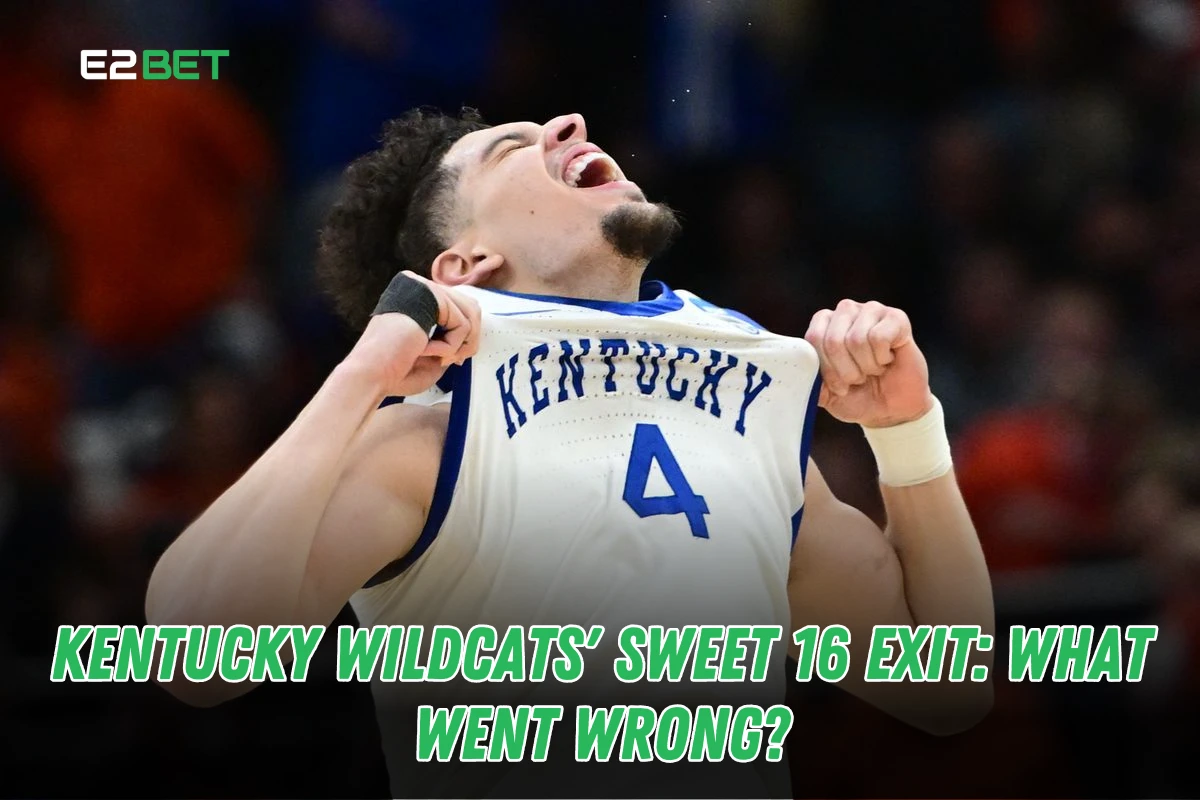The Kentucky Wildcats entered the NCAA tournament with high hopes, boasting a strong roster and a history of deep runs in March Madness. However, their journey ended in disappointment as they fell in the Sweet 16. Fans and analysts were left wondering—what went wrong? This article breaks down the key factors that led to Kentucky’s early exit and what this means for the program moving forward. If you’re searching for an in-depth Kentucky basketball season review, keep reading.
Kentucky Wildcats’ Performance in the NCAA Tournament
Regular Season and Tournament Path
The Wildcats had an impressive regular season, securing significant wins against top-ranked teams. Their dominant performances earned them a solid seeding in the tournament. However, as they advanced, cracks in their strategy and execution began to show, leading to their Sweet 16 elimination.

Strengths That Got Them This Far
- Strong three-point shooting, which helped in previous rounds
- Solid rebounding ability, keeping them competitive
- Aggressive defense early in the tournament, showcasing their potential
Key Factors Behind Kentucky Wildcats’ Sweet 16 Exit
Defensive Struggles
Inconsistent Defense
Kentucky’s defense, which had been a cornerstone of their success, faltered in the Sweet 16. The team struggled with rotations and allowed their opponents too many open looks. This exposed their defensive weaknesses, affecting their March Madness performance stats.
Failure to Contain Key Players
The Wildcats’ defense failed to lock down the opposing team’s top scorers, allowing them to take control of the game. The lack of adjustments raised concerns about John Calipari’s coaching decisions.
Offensive Inefficiency
Shooting Struggles
Cold shooting plagued Kentucky, with poor field goal percentages and missed three-pointers at critical moments. Wildcats Sweet 16 stats reflect their struggles in key moments.
Turnover Issues
Sloppy ball-handling and unforced errors disrupted their offensive flow, leading to easy points for the opponent. Many fans pointed out the need for better ball-handling and playmaking in high-pressure situations.
Lack of Offensive Rhythm
The offense failed to establish consistency, with multiple possessions ending in rushed or contested shots. Analysts on Kentucky Wildcats’ ESPN page highlighted this as a major issue.
Coaching and Tactical Decisions
Questionable Game Plan
Some of John Calipari’s coaching strategies were called into question, including rotations and play-calling in key moments.
Lack of Adjustments
Despite clear struggles, Kentucky did not make effective halftime adjustments to counter the opposing team’s game plan. As noted in NCAA tournament expert predictions, strategic flexibility is crucial at this stage.
Opponent’s Dominance
Exploiting Kentucky’s Weaknesses
The opposing team executed a game plan that targeted Kentucky’s vulnerabilities, particularly in transition defense. A breakdown of the Sweet 16 post-game analysis shows how Kentucky failed to adapt.
Key Opponent Performances
The Wildcats allowed opposing players to have standout performances, failing to contain their best scorers. Looking at March Madness Sweet 16 highlights, it’s clear Kentucky couldn’t keep up.
Injuries and Player Fatigue
Impact of Injuries
Key players were not at full strength, limiting Kentucky’s depth and effectiveness. Wildcats NCAA memorabilia store features past rosters that have faced similar challenges.
Fatigue in the Second Half
As the game progressed, Kentucky players showed signs of exhaustion, leading to late-game collapses. A Kentucky basketball team breakdown shows that this has been an issue in past tournaments as well.
Lessons Learned and What’s Next for Kentucky Wildcats
Future Roster Changes
Potential Departures and New Recruits
Some players may declare for the NBA draft, while incoming recruits and transfers could reshape the team. Kentucky Wildcats recruiting news will be crucial in shaping next season’s outlook.
Areas Needing Improvement
- Perimeter defense to prevent open shots
- Better offensive execution under pressure
- Stronger leadership in critical moments
Coaching Adjustments
Will There Be Strategy Changes?
Coach Calipari may need to rethink his approach, particularly in high-pressure tournament games. Fans visiting the Kentucky basketball official website are eager to see how he responds.
Potential Staff Changes
A shake-up in the coaching staff could be on the horizon to address persistent issues.
Road to Redemption
Offseason Training Focus
The team must prioritize defense, mental toughness, and closing out games. Wildcats basketball practice schedule will be key in monitoring their improvement.
Mindset for Next Season
Kentucky will need to enter the next season with renewed determination and a hunger to prove doubters wrong. Wildcats season pass tickets are already in high demand as fans look forward to their comeback.
Conclusion
The Wildcats’ Sweet 16 exit was a tough pill to swallow, but it highlighted critical areas for improvement. With roster changes, coaching adjustments, and a stronger mentality, Kentucky can bounce back next season. Their loyal fan base will be eager to see how the program responds.
FAQs
Q1. Why did the Kentucky Wildcats lose in the Sweet 16?
Ans. Defensive struggles, offensive inefficiency, coaching decisions, and fatigue all contributed to their loss.
Q2. What were the biggest mistakes Kentucky made in the game?
Ans. Poor shooting, defensive lapses, and failure to make key in-game adjustments were their biggest issues.
Q3. How did the coaching strategy impact the loss?
Ans. Questionable rotations, lack of adjustments, and poor late-game management hurt Kentucky’s chances.
Q4. What changes can be expected in the next season?
Ans. New recruits, tactical adjustments, and possibly some coaching staff changes could shape next season’s team.
Q5. Who were the standout players despite the loss?
Ans. While the team struggled, a few players showed resilience, but individual performances weren’t enough to secure a win.